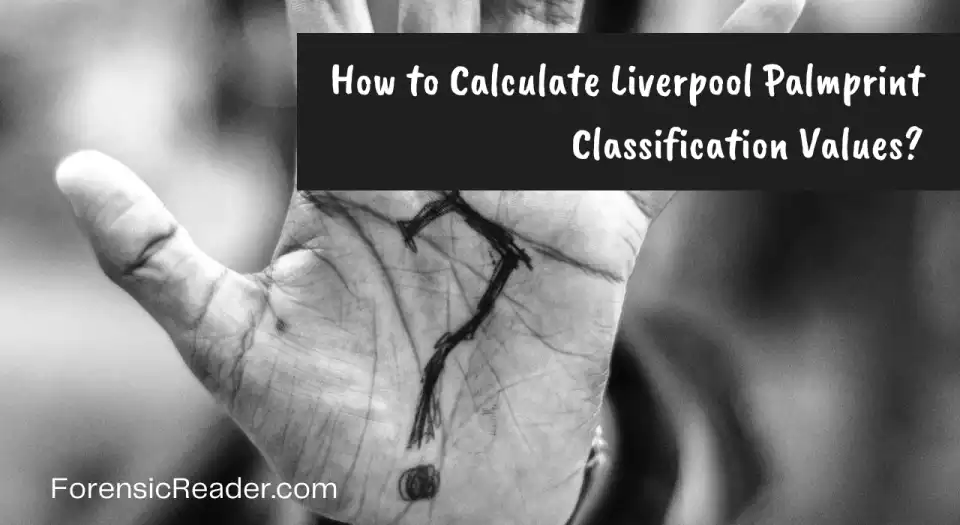Liverpool Palmprint Classification System (LPCS) is one of the easy-to-understand palm print classifications whose values are in alphabetic and numeric code arranged in special coding boxes. It was housed in Liverpool, England.

[Table] Sub-Classification of LPCS and Palm Areas

| Liverpool Palmprint Division | Palm Area | Coding Values |
|---|---|---|
| Primary | All 3 pattern area | Numeric |
| Secondary | Hypothenar | Alphabetic |
| Tertiary | Thenar | Alphabetic |
| Quaternary | Interdigital | Alphabetic & Numeric |
How to Calculate Liverpool Palm Print Classification Values?

A. Primary Division
The primary division uses a set of values based on any type of pattern that appears in any of the three palm sections. In the case of more than one pattern in a palm area, even then, only a single value is given.
Read More: Western Australian Palmprint Classification System and Subdivisions
Table for Pattern Indication from Primary Values
However, if patterns appear in more than one palm section, then cumulative summed values in assigned all values are given in the following table.
| Pattern | Primary Value |
|---|---|
| No pattern in area | 1 |
| Thenar only | 2 |
| Interdigital only | 3 |
| Hypothenar only | 4 |
| Thenar and interdigital only | 5 |
| Thenar and hypothenar only | 6 |
| Interdigital and hypothenar only | 7 |
| Patterns in all three areas | 9 |
B. Secondary Classification
Secondary palmprint classification has another extension called subsecondary classification. The values are governed by the pattern in the hypothenar part only and are assigned as the alphabetic code.
More than one Pattern in Hypothenar Area:
The classification box is separated by a diagonal line (bottom left to the upper right).
- Left Upper Half: designated the pattern symbol of the pattern closest to the interdigital area.
- Lower Right Half: designated for the pattern symbol of the pattern closest to the wrist.
Following are the alphabetic codes used in secondary classification:
| Pattern Type | Symbols |
|---|---|
| Whorl A (circular) | A |
| Whorl B (elliptical) | B |
| Twinned loop | TL |
| Lateral pocket loop | LP |
| Central pocket loop | CP |
| Accidental/composite | ACC |
| Tented arch | T |
| Loop core inward | I |
| Loop core outward | O |
| Loop core downward | D |
| Loop core upward | U |
| Loop core nutant | K |
| Nondescript | N |
| Plain arch | N |
| No pattern | |
| High carpal delta | H |
| Low carpal delta | L |
Second Subsecondary Classification
It involves two subclassifications:
- Single loop in the hypothenar: record the number of ridge characteristics in the core area.
- Devoid pattern in hypothenar: record the type of delta.
Read More: Henry Fingerprint Classification System: Key, Major, Primary, Secondary, Subsecondary and Final
C. Tertiary Classification
The thenar section of the palm is used to obtain the value of this classification.
Like primary classification, if two patterns are in the thenar area, the box was separated by a diagonal line.
- Left Upper Half: designated the pattern symbol of the pattern closest to the interdigital area.
- Lower Right Half: designated for the pattern symbol of the pattern closest to the wrist.
D. Quaternary Classification
The quaternary classification is subdivided into three divisions:
- Part 1
- Part 2
- Part 3
Part 1 of Quaternary Classification
- Types of patterns in the interdigital area.
- More than one pattern in the area, a diagonal box separated by three diagonal lines.
- Upper left third: pattern closest to the index finger
- Botton right third: pattern closest to the little finger
Part 2 of Quaternary Classification
- Specific predetermined numerical values indicate the position of the pattern in relation to fingers.
- More than one pattern: combined the numeric values into a single value.
- Pattern between the base of two Fingers: record the higher value.
Following is the table for the given set of values:
| Position of Pattern | Value |
|---|---|
| Under index finger | 8 |
| Under middle finger | 4 |
| Under ring finger | 2 |
| Under little finger | 1 |
Part 3 of Quaternary Classification
- Record counts of tented arches or loops (inward core, outward core, and downward core loops) in the interdigital area.
Read More: 11 Reasons and Importance of Why Fingerprints Used for Identification in Forensic Science
References:
- The Fingerprint Sourcebook By United States Department of Justice [Link]
- Abstracts on Police Science, Volume 2 [Book]
- Advances in Fingerprint Technology [Link]
- Palm Print Recognition System: Need, Uses, and Working

FR Author Group at ForensicReader is a team of Forensic experts and scholars having B.Sc, M.Sc, or Doctorate( Ph.D.) degrees in Forensic Science. We published on topics on fingerprints, questioned documents, forensic medicine, toxicology, physical evidence, and related case studies. Know More.
